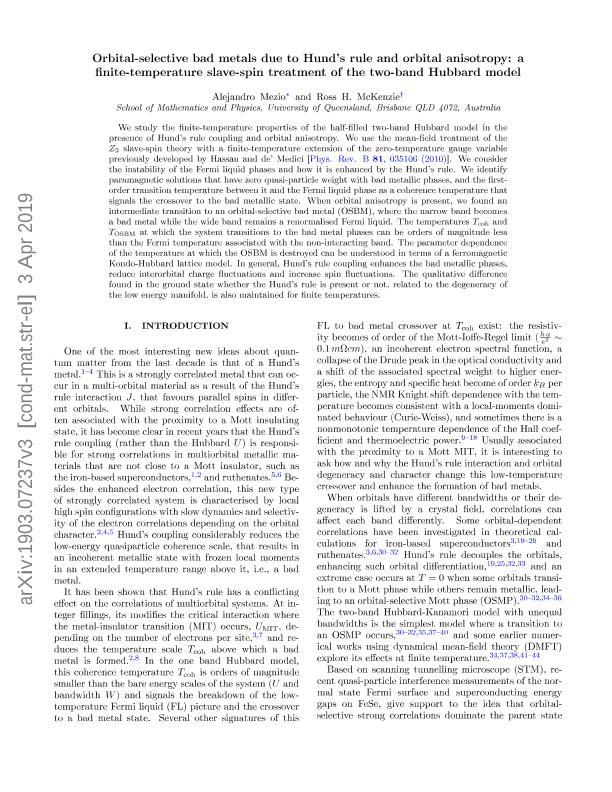Artículo
Orbital-selective bad metals due to Hund’s rule and orbital anisotropy: A finite-temperature slave-spin treatment of the two-band Hubbard model
Fecha de publicación:
11/2019
Editorial:
American Physical Society
Revista:
Physical Review B: Condensed Matter and Materials Physics
ISSN:
1098-0121
Idioma:
Inglés
Tipo de recurso:
Artículo publicado
Clasificación temática:
Resumen
We study the finiteerature properties of the half-filled two-band Hubbard model in the presence of Hund's rule coupling and orbital anisotropy. We use the mean-field treatment of the Z2 slave-spin theory with a finiteerature extension of the zeroerature gauge variable previously developed by Hassan and de' Medici [Phys. Rev. B 81, 035106 (2010)10.1103/PhysRevB.81.035106]. We consider the instability of the Fermi-liquid phases and how it is enhanced by the Hund's rule. We identify paramagnetic solutions that have zero quasiparticle weight with a bad metal, and the first-order transition temperature between the bad metal and the Fermi-liquid phase as a coherence temperature that signals the crossover to the bad metallic state. When orbital anisotropy is present, we found an intermediate transition to an orbital-selective bad metal (OSBM), where the narrow band becomes a bad metal while the wide band remains a renormalized Fermi liquid. The temperatures Tcoh and TOSBM at which the system transitions to the bad metal phases can be orders of magnitude less than the Fermi temperature associated with the noninteracting band. The parameter dependence of the temperature at which the OSBM is destroyed can be understood in terms of a ferromagnetic Kondo-Hubbard lattice model. In general, Hund's rule coupling enhances the bad metallic phases, reduces interorbital charge fluctuations, and increases spin fluctuations. The qualitative difference found in the ground state whether the Hund's rule is present or not, related to the degeneracy of the low-energy manifold, is also maintained for finite temperatures.
Archivos asociados
Licencia
Identificadores
Colecciones
Articulos(IFIR)
Articulos de INST.DE FISICA DE ROSARIO (I)
Articulos de INST.DE FISICA DE ROSARIO (I)
Citación
Mezio, Alejandro; McKenzie, Ross H.; Orbital-selective bad metals due to Hund’s rule and orbital anisotropy: A finite-temperature slave-spin treatment of the two-band Hubbard model; American Physical Society; Physical Review B: Condensed Matter and Materials Physics; 100; 20; 11-2019; 1-16
Compartir
Altmétricas




